Ruta de navegación
Menú de navegación
Blogs
Entries with Categories Global Affairs Reports .
POLITICAL RISK REPORT / Andrea Izco, Elena López-Doriga and Lucía Sáez
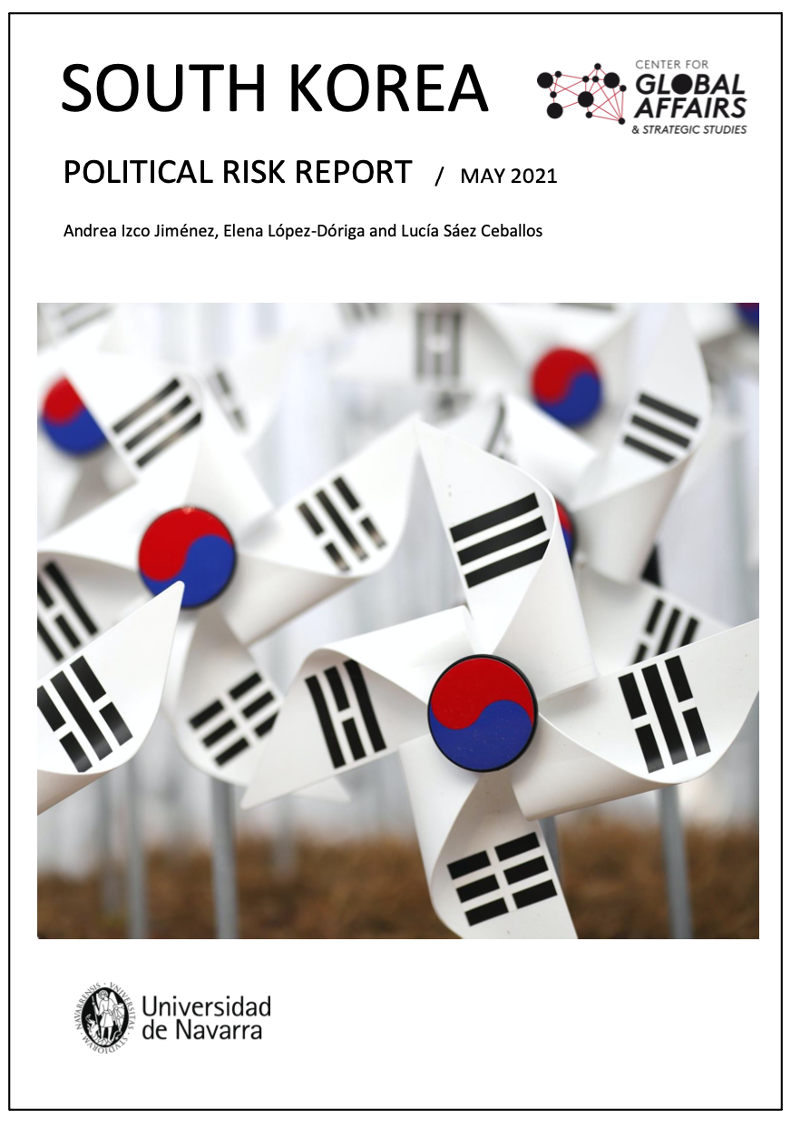
Download the document [pdf. 1MB].
EXECUTIVE SUMMARY
The purpose of this political risk report is to analyze how stable the political, economic, and social conditions of South Korea are to determine the best approach to invest in this country.
Firstly, regarding the Economic Outlook, the GDP is expected to increase 3.6% in 2021 and 2.8% in 2022 and the government has devoted to get out of the crisis through the Korean-New Deal. Concerning heavy industry, manufacturing, and AI and technology, South Korea is taking action to become a potential leader. In terms of energy, the country's high dependence on energy imports because of its scarcity of natural resources motivates them to move towards renewable energies as well as to maintain its energy security.
Secondly, in relation to South Korea's Social Outlook, the country has shown great social cohesion after the COVID-19 crisis with responsible action by the population. The birth rate is expected to remain very low, but still, the need for immigrants has not been an easy response as nationals feel a certain threat. Regarding religion, the notion of democracy is what brings South Korea closer to the Western World, not too much the notion of Christianity, but even having a democratic system, many Confucian values still remain. It is safe to say that even though Koreans are likely to become less institutionally committed, the decline on religion will be minimal and regarding social stability, there will not be social confrontations between the different groups.
Thirdly, in the Political Outlook we see how South Korea's democracy faces issues concerning the powerful executive connected to a crony capitalism system in which Chaebols have been related to political scandals in the last administrations. However, in the short-term, the government will focus on resolving partner-economic issues rather than taking system reforms, as a new form of populism is emerging claiming for solutions for inequalities and damage caused by modernity. Despite of the little economic progress carried out by the current administration under President Moon, it is likely that his party will win again the next presidential elections in 2022 thanks to the well management of the COVID-19 crisis.
Finally, the Inter-Korean question can be concluded by saying North Korea is not willing to open up and instead takes minimal reforms. Despite of the struggles caused by the crisis and the commitment to dialogue from South Korea under the so-called Sunshine Policy, little progress has been achieved.
STRATEGIC ANALYSIS REPORT / Marina Díaz, Lucía Montón and Paula Mostajo
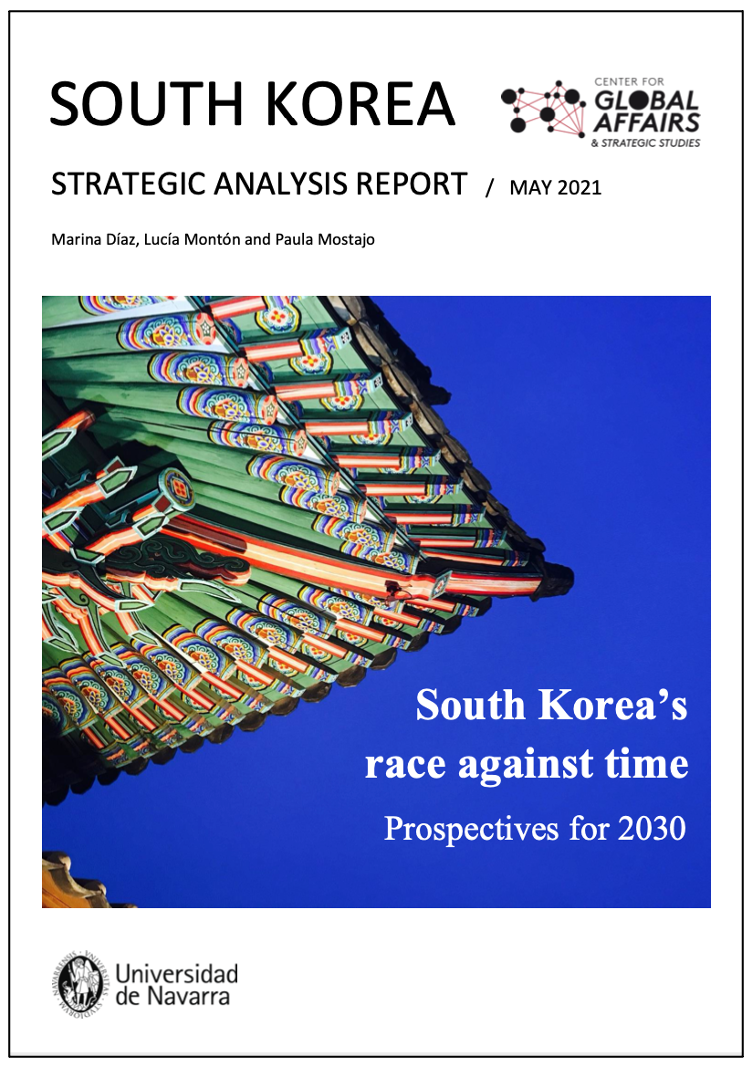 Download the Document] [Download the Document
Download the Document] [Download the Document
EXECUTIVE SUMMARY
South Korea is considered to have a middle power status, not only in the North-East Asian region but internationally. In this sense, this paper aimed to provide a comprehensive understanding of the stance South Korea might take regarding key international, regional, peninsular and domestic issues in ten years time.
In the international sphere, this paper has focused on the US-ROK stating the plausibility of a further enhancement, in view of the new Biden's Administration's need to reduce the breach created by former President Trump.
Regarding the regional sphere, the present report addresses South Korea's relations with China, in economic matters; Japan, alliance-wise, and Russia, in relation with energy. These bilateral engagements are clearly impacted by South Korea's proximity to the United States, the country's historical memory and North Korea's willingness to be part of a trilateral understanding, respectively.
Second to last, the peninsular approach of the script assesses the development of inter-Korean relations in views of the two incompatible ideologies and approaches coming from the North and the South of the peninsula and presents the maintenance of the current status has the most plausible scenario.
To end up, there is an allusion to domestic concerns as they play an important role in South Korea's development capabilities. In this section the paper discusses the country's SARS-CoV-2 disease successful management and assess why export possibilities might not be taken for granted, the big South Korean concerns on the ever-worsening demographic situation and, lastly, the country's satisfactorily progression towards renewable energy sources.
The Republic of Korea case study: How the Inter-Korean Conflict is an indication of the New Cold War
STRATEGIC ANALYSIS REPORT / Corey J. Hubbard and Paula Mora Brito

EXECUTIVE SUMMARY
Intense military pressures on South Korea have been present for half a century, with the country being at the centre of numerous regional conflicts. The government's technique for addressing external security threats differs depending on its nature, varying from assuming the position of great foreign powers to implementing its independent policy. The Republic of Korea's reliance on foreign assistance for defence and protection shows no signs of ending, especially concerning North Korea. The incitement of Kim Jong Un's government risks hostility in the region.
The country is under growing domestic pressures to find solutions for a rapidly ageing population and record low birthrates, one of the world's weakest. Failure to do so compromises South Korea's status as a growing power in East Asia, one of the four Asian Tigers, and risks leading the country to economic stagnation. Suppose the South Korean government does not find a way to make immigration more palatable to the Korean people. In that case, it is unlikely that South Korea will avoid a significant population decline.
Well-established antagonism with Japan could worsen as Japanese nationalist policies conflict with the South Korean government's goals. However, the recent signing of the Regional Comprehensive Economic Partnership opens up several possible developments in Korean-Japanese relations, extending from an unlikely reset in their bilateral ties to an equally unlikely economic confrontation. The Liancourt Rocks dispute also stands to be influenced by recent events, which may incline South Korea to turn to foreign mediation on the issue.
South Korean relations with the United States are evolving, with the Biden Administration recently inking a new cost-sharing deal with the South Korean Government to cover the expenses of American troops stationed on the Peninsula. Nevertheless, China's growing influence threatens to overturn the established order in the region, and a rapprochement of South Korea to China may take place over the coming decades.
The future security of South Korea is directly tied to developments on the Korean Peninsula. Suppose relations with the North Korean Regime significantly improve, which most expect to be unlikely in the near future. In that case, reunification may result, but North Korea's nuclear weapons development could destabilise the region too. Scenarios relating to these events vary from an unlikely reunification to an equally unlikely nuclear war.
South Korea's attempts at navigating the growingly tense feud between the United States and China may force the country to choose a side in the conflict, which will have severe ramifications for its security architecture.
STRATEGIC ANALYSIS REPORT / María G. Fajardo, Marcelina Kropiwnicka and Matilde Romito

EXECUTIVE SUMMARY
The Korean Peninsula is central to the political, economic and military policies of several actors in the East Asia region. Due to its geographical location, the peninsula has seen the involvement of major powers throughout history, like the United States, China, Russia and Japan. Currently, the peninsula is a contested territory between the U.S. and China. The latter is the only country capable of challenging American interests and uses its economic power to increase its sphere of influence in the region.
The DPRK has built and maintained capabilities to target areas as far as U.S. soil. The North has always represented one of the biggest challenges for South Korea and its security guarantor, the U.S. President Biden will nevertheless sway for establishing a network line for Kim to potentially cross and instead, new sanctions could be expected despite their lack of effectiveness.
For the U.S. to maintain its dominant role in the East Asia region, deter North Korea, and keep China in check, it must reaffirm its military and economic alliances which entered into a period of uncertainty during the Trump administration. Currently, China is South Korea's principal trading partner and is openly evading international sanctions imposed on North Korea being its principal trading partner as well.
The prosperous South Korea will remain neutral in many aspects related to China, yet if put in a situation where it has to choose between the U.S. and China, it will incline towards the former, which remains its security guarantor. When it comes to Russia, its role in the Korean conflict is now secondary but over the years, Russia has used the U.S.-China battle to increase relations with the latter. In the case of Japan, a close U.S. ally, a shift in relations with the ROK is unlikely to happen any time soon since their political issues have evolved into legal ones. This will remain detrimental to the U.S' New East China Sea policy which requires cooperation between U.S. allies.
Diplomacy, openness and potential reunification in the peninsula depend on external actors. Neither reunification nor openness are likely to take place in the short term due to Kim's personality and the preference of external actors to maintain the status quo. A reunification led under peaceful terms would be most desirable and would ultimately lead to an even larger economic powerhouse in the region. For the U.S, this pathway would be most beneficial if a reunified Korea would align with the U.S. This would be detrimental, however, to China's geopolitical interests in the region. Russia could come out as being the greatest benefactor from a peaceful reunification. Lastly, Japan could continue to feel threatened by a reunified Korea, which is united by hatred over a colonial past under Japanese savage rule.
[Michael J. Seth, A Concise History of Modern Korea. From the Late Nineteenth Century to the Present (Plymouth, UK: Rowman & Littlefield, 2019), Volume 2, 356 pages]
REVIEW / Jimena Villacorta
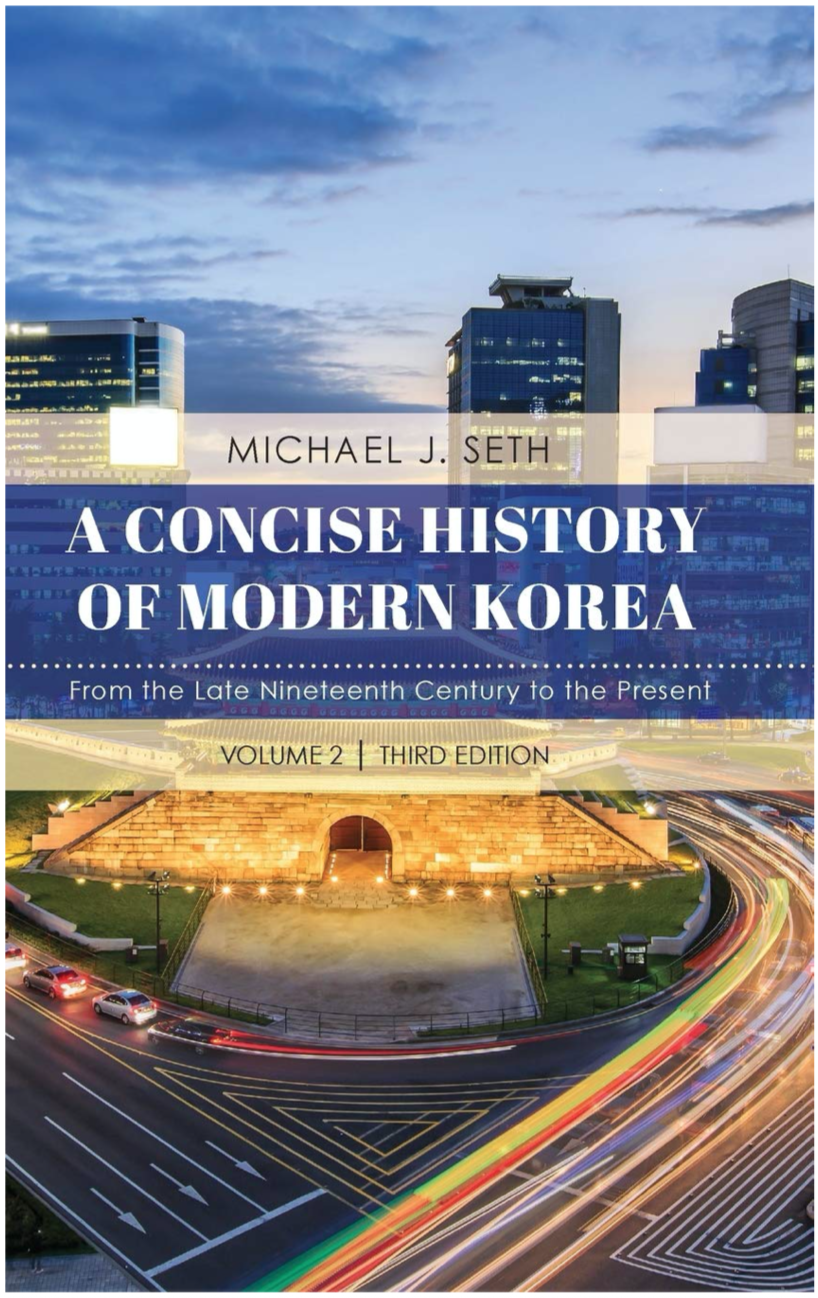
Normally, when thinking about the Korean Peninsula, we emphasize on the divided region it is now, and how the Korean War (1950-1053) had a great impact on the two independent territories we have today, North and South Korea. We forget that it once was a culturally and ethnically homogenous nation, that because of its law, couldn't even trade with outsiders until the Treaty of Kanghwa in 1876 which marked a turning point in Korean history as it ended isolation and allowed the Japanese insertion in the territory which had great effects on its economic and political order.
Michael J. Seth narrates the fascinating history of Korea from the end of the 19th century to the present. In this edition he updates his previous work, originally published ten years before, and he presents it as a "volume 2", because his latest years of research have produced a "volume 1", entitled A Concise History of Premodern Korea, which follows Korea's history from Antiquity through the nineteenth century.
From falling under Japanese imperialism and expansionism to its division after the Second World War, this book explores the economic, political and social issues that modern Korea has faced in the last decades. The author provides its readers a great resource for those seeking a general, yet detailed, history of this currently divided nation in eight chapters. The first two chapters focus on what happened before the Korean War and on how neighbors and other actors. Russia had great influence in the region until its defeat in the Russo-Japanese War (1904-1905). Consequently, Korea became a colony of Japan until the Allied Forces victory during the Second World War. Japanese rule is described as harsh and detrimental for Koreans as they intended to force their own culture and system in the territory. Although, in despite of its aggressiveness, the Japanese contributed to Korea's industrialization. Countries like China and the United States were also major players. From 1885 to 1894, China had a strong presence in the peninsula as the Chinese didn't want other powers to take over the territory.
The rest of the book emphasizes on the war and the consequences it had, tracing the different course both countries took becoming contrasting societies with different political and economic systems. The reason for the great differences between the two Koreas is the difference in governments and influences they had after the war, a war that stopped because of a ceasefire, as to date they haven't signed a peace treaty. Even if South Korea was under Syngman Rhee's authoritarian and corrupt regime tight after the Korean War, it soon became democratized and the country began to quickly advance in matter of technology and human development leaving North Korea out in the open under a totalitarian dictatorship lead by Kim Jong-un. However, after the separation of the two zones, Kim II-sung was the founder of the North in 1948 and his family dynasty has ruled the country since then. During this period, South Korea has had six republics, one revolution, two coups d'état, the transition to democratic elections and nineteen presidencies. In terms of economics, they went from having a very similar GDP at the beginning of the 1970s to very different outcomes. While South Korea has progressed rapidly, becoming one of the world's leading industrial producers, North Korea became stagnant due to its rigid state system. South Korea also has a high level of technological infrastructure. Moreover, North Korea became a nuclear power, which has been in its diary since the division. But as he explores the technical differences of both states, the author fails to elaborate in historical debates and controversies regarding both regions, but he emphasizes on the fact that after sixty years of division, there are still no signs or reunification.
Without a doubt, it is interesting to learn about Korea's past colonial occupation and its division, but what I believe is the most captivating is to understand how North Korea and South Korea have evolved as two independent very different states because of the uniqueness and complexity of its history, while still sharing a strong sense of nationalism. As the author says, "No modern nation ever developed a more isolated and totalitarian society than North Korea, nor such an all-embracing family cult. No society moved more swiftly from extreme poverty to prosperity and from authoritarianism to democracy than South Korea".

GLOBAL AFFAIRS JOURNAL #3 / January 2021
 [download the PDF of the full Journal]
[download the PDF of the full Journal]
The balloon rotates some Degrees further to the West.
PRESENTATION
There was a time when the world's strategic axis was in Europe. With the incorporation of the New World into the global order, the axis shifted for a long time to the Atlantic, between Europe and America. The consolidation of the primacy of the United States made it the pivot of the world. With development of the Asian tigers, the specific weight of the planet shifted towards the Pacific, between America and Asia. Afterwards, the initial concept of Asia-Pacific gradually lost the sense of space between two coasts to eventually refer only to the shore where China is located, as it has grown as a superpower and has focused general attention. We are now witnessing another progression in the rotation of the globe, again some Degrees further west. Asia-Pacific gives way to the idea of Indo-Pacific by bringing India into the equation. And it is possible that in the future, as Eurasia becomes more compact and Africa becomes more involved in international decision-making, the way to look at the world map will be to have the Indian Ocean in the middle, as a global Mediterranean.
Today, in any case, we are ushering in the Indo-Pacific moment. It is a new world order in which China no longer occupies the centre where it aspired to be: the ground has begun to shift before it can fully settle. Beijing's own strategic haste has triggered the mobilisation of the Asian environment, which is partly supported by India which, due to its demographic size and economic potential, can serve as a lever for China's continental counterweight. Global Affairs Journal addresses in this issue the articulation of this counterweight, which revolves around the initiatives of a Free and Open Indo-Pacific and the so-called Quad, whose vertexes are Japan, India, Australia and the United States, with implications for ASEAN as well.
Index
THE INDO-PACIFIC AS A NEW GLOBAL GEOPOLITICAL AXIS
Juan Luis López Aranguren [Introduction].
Professor of International Office, University of Zaragoza
p. 6-11 [PDF version].
PRESENT COMPLEXITIES AND FUTURE PROSPECTS
Shahana Thankachan
Researcher at the Jawaharlal Nehru University, India
p. 12-17 [PDF version].
UNITED STATES AND AUSTRALIA BEFORE
THE EMERGENCE OF CHINA AS A GREAT POWER
Florentino Portero
Director from high school of International Politics, Universidad Francisco de Vitoria
p. 18-27 [PDF version].
FREE AND OPEN INDO-PACIFIC: A JAPANESE INITIATIVE
FOREIGN POLICY FOR GLOBAL COOPERATION
Carmen Tirado Robles
Coordinator of the group of research Japan, University of Zaragoza
p. 28-35 [PDF version].
THE ASEAN'S INDO-PACIFIC DILEMMA
Fernando Delage
Director of the Department of International programs of study , Universidad Loyola Andalucía
p. 36-43 [PDF version].
RECOMMENDED READING
J. L. López Aranguren, S. Sánchez Tapia
E. J. Blasco, A. Puigrefagut
p. 44-46 [PDF version].
![Artistic image of a Pakistani Rupee [Pixabay]. Artistic image of a Pakistani Rupee [Pixabay].](/documents/10174/16849987/pakistan-country-risk-report-blog.jpg)
▲ Artistic image of a Pakistani Rupee [Pixabay].
COUNTRY RISK REPORT / M. J. Moya, I. Maspons, A. V. Acosta
EXECUTIVE SUMMARY
The government of Prime Minister (PM), Imran Khan, was slowly moving towards economic, social, and political improvements, but all these efforts might be hampered by the recent outbreak of the COVID-19 virus since the government must temporarily shift its focus and resources to keeping its population safe. Additionally, high logistical, legal, and security challenges still generate an uncompetitive operating environment and thus, an unattractive market for foreign investment in Pakistan.
Firstly, in relation to the country's economic outlook, Gross Domestic Product (GDP) was expected to gradually recover around 5% in the upcoming years. However, according to latest estimates, this growth will suffer a negative impact and fall to around 2%, straining the country's most recent recorded improvements. On the other hand, in the medium to long-term, Pakistan will benefit from the success of the China-Pakistan Economic Corridor (CPEC), which is a strategic economic project aiming to improve infrastructure capacity in the country. Pakistan is also facing an energy crisis along with a growing demand from a booming population that hinder a proper economic progress.
Secondly, Pakistan's political future will be shaped by Khan's ability to transform his short-term policies into long-term strategies. However, in order to achieve this, the government must tackle the root causes of political instability in Pakistan, such as long-lasting corruption, the constant military influence in decision-making processes, the historical discussion among secularism and Islamism, and the new challenges posed by the COVID-19 pandemic. Still, PM Khan's progressive reforms could represent the beginning towards a "Naya Pakistan" ("New Pakistan").
Thirdly, Pakistan's social stability is contextualized within a high risk of terrorist attacks due to its internal security gaps. The ethnic dilemma among the provinces along with the government's violent oppression of insurgencies will continue to impede development and social cohesion within the country. This will further aggravate in light of a current shortage of resources and the impacts of climate change.
In addition, in terms of Pakistan's security outlook, the country is expected to tackle terrorist financing and money laundering networks in order to avoid being blacklisted by the Financial Action Task Force (FATF). Nonetheless, due to a porous border with Afghanistan, Pakistan faces drug trafficking challenges that further destabilize national security. Finally, the turbulent Indo-Pakistani relation is the most significant conflict for the South Asian country. The disputed region of Jammu and Kashmir, a possible nuclear confrontation, and the increase of nationalist movements along the Punjab region, hamper regional and international peace.
![A view of the Badshahi Mosque, in Lahore, capital of the Punjab province [Pixabay]. A view of the Badshahi Mosque, in Lahore, capital of the Punjab province [Pixabay].](/documents/10174/16849987/pakistan-mayo-2020-blog.jpg)
▲ A view of the Badshahi Mosque, in Lahore, capital of the Punjab province [Pixabay].
STRATEGIC ANALYSIS REPORT / Naomi Moreno, Alejandro Puigrefagut, Ignacio Yárnoz
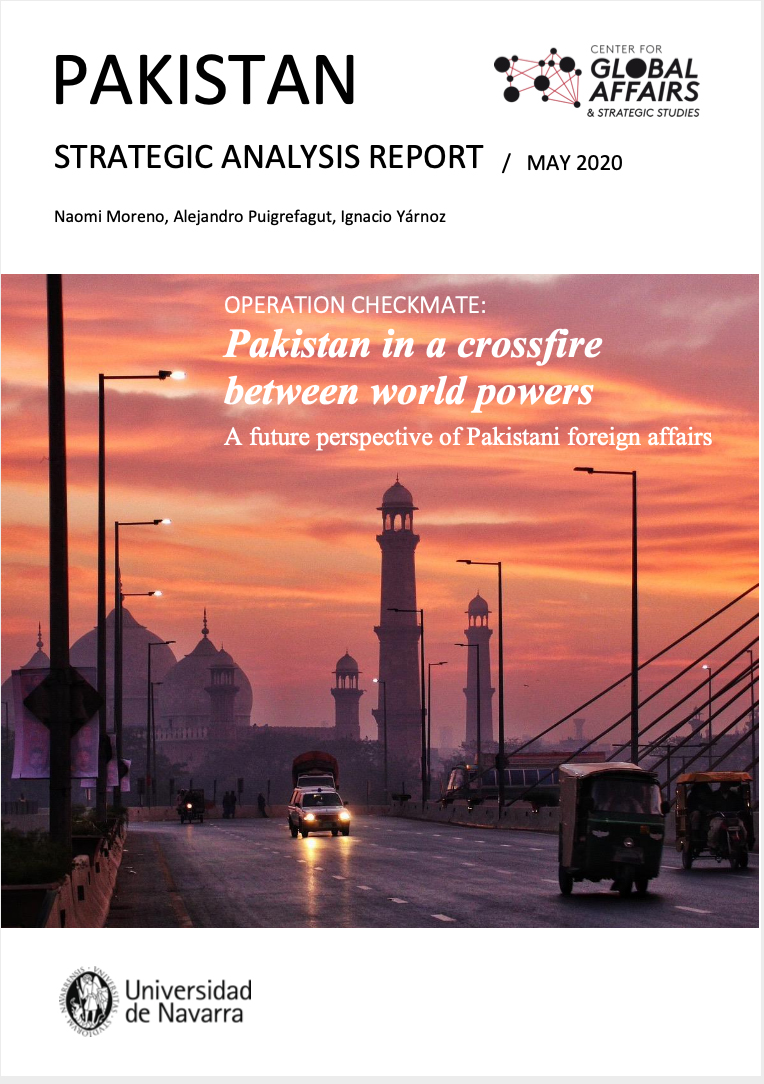 Download the document [pdf. 1,4MB] [pdf. 1,4MB
Download the document [pdf. 1,4MB] [pdf. 1,4MB
EXECUTIVE SUMMARY
This report has been aimed at examining the future prospects for Pakistan in the 2025 horizon in relation to other States and to present various scenarios through a prospective strategic analysis.
The research draws upon the fact that, despite the relatively short space of time, Pakistan is likely to undergo several important changes in its international affairs and thus feel forced to rethink its foreign policy. This strategic analysis suggests there could be considerable estrangement between the U.S. and Pakistan and, therefore, the American influence will decrease considerably. Their security alliance could terminate, and Pakistan would cease to be in U.S.' sphere of influence. Moreover, with the new BRI and CPEC projects, China could move closer to Pakistan and finally become its main partner in the region. The CPEC is going to become a vital instrument for Pakistan, so it could significantly increase Chinese influence. Yet, the whole situation risks jeopardizing Pakistan's sovereign independence.
India-Pakistan longstanding dispute over Kashmir seems to be stagnated and will possibly remain as such in the following years. India has taken steps to annex its administered territory in Jammu and Kashmir and Pakistan could potentially follow. The possibility of an open conflict and a nuclear standoff remains possible as both nuclear powers have very different strategies and conceptions which could lead to misinterpretation and a nuclear escalation.
In the quest to rethink its foreign policy, the U.S.-Taliban peace and the empowerment of the group has come as a bolt from the sky for Pakistan. Through its ties with the Taliban, Pakistan could gain itself a major presence in the region namely by reaching out to Central Asia and advance its interest to curtail India's influence. Amid a dire economic crisis, with regards to the Saudi Iranian Cold War, Pakistan could seek a way in which it can recalibrate its stance in favour of the resource-rich Saudi alliance while it appeases sectarian groups who could strongly oppose this potential policy.
Pakistan ought to acknowledge that significant changes ought to be made in both the national and international sphere and that decisive challenges lay ahead.
![A woman crosses a bridge in a rural area of Pakistan [Pixabay]. A woman crosses a bridge in a rural area of Pakistan [Pixabay].](/documents/10174/16849987/pakistan-report-blog.jpg)
▲ A woman crosses a bridge in a rural area of Pakistan [Pixabay].
STRATEGIC ANALYSIS REPORT / Naiara Goñi, Roberto Ramírez, Albert Vidal
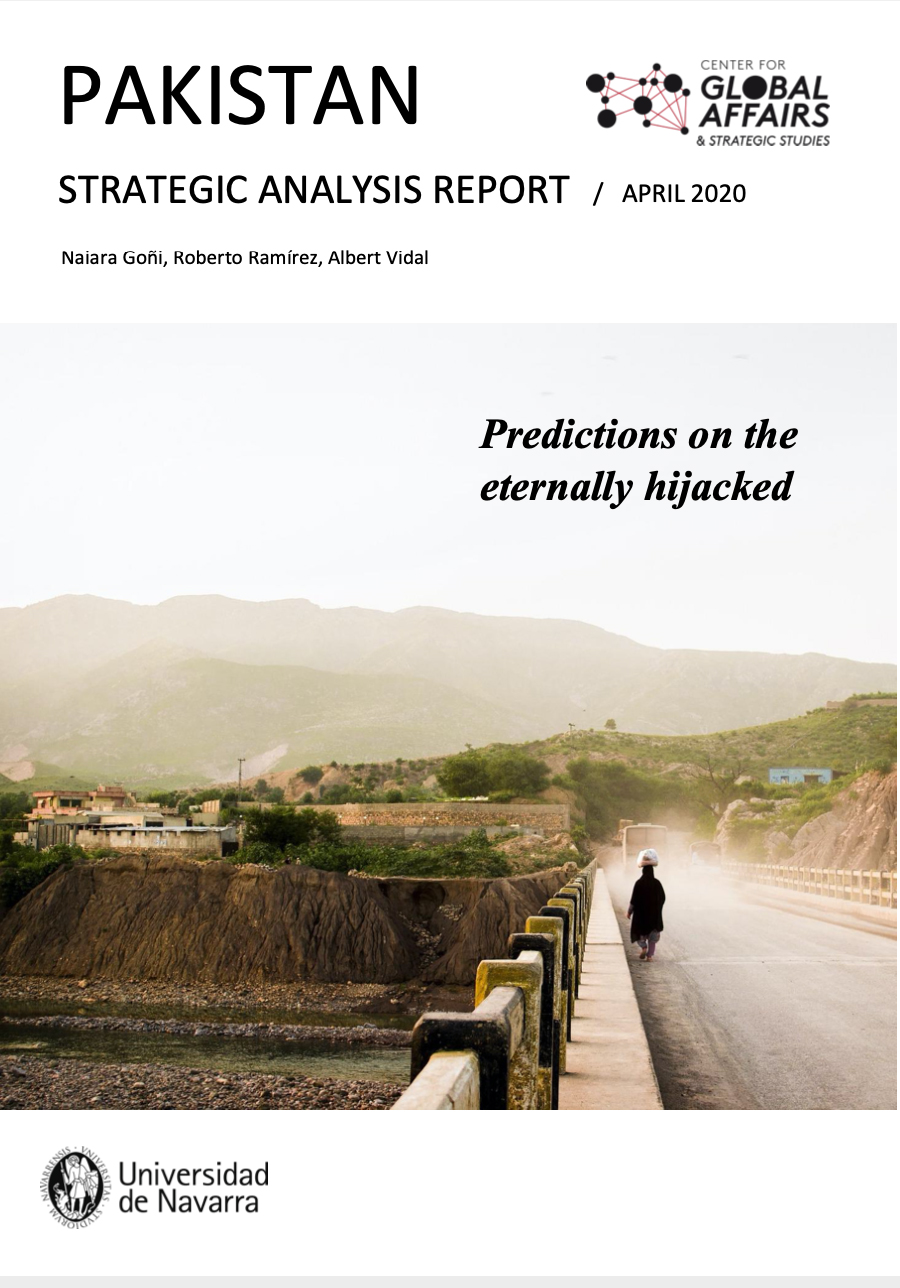 Download the document [pdf. 1,4MB] [pdf. 1,4MB
Download the document [pdf. 1,4MB] [pdf. 1,4MB
EXECUTIVE SUMMARY
The purpose of this strategic analysis report is to ascertain how geopolitical dynamics in and around Pakistan will evolve in the next few years.
Pakistani relations with the US will become increasingly transactional after the US withdrawal from Afghanistan. As the US-India partnership strengthens to face China, the US will lose interest in Pakistan and their priorities will further diverge. In response, Beijing will remain Islamabad's all-weather strategic partner despite claims that the debt-trap could become a hurdle. Trade relations with the EU will continue to expand and Brussels will not use trade leverage to obtain Human Rights concessions from Islamabad. Cooperation in other areas will stagnate, and the EU's neutrality on the Kashmir issue will remain unchanged.
In Central Asia, Islamabad will maintain positive relations with the Central Asian Republics, which will be based on increasing connectivity, trade and energy partnerships, although these may be endangered by instability in Afghanistan. Relations with Bangladesh will remain unpropitious. An American withdrawal from Afghanistan will most likely lead to an intensification of the conflict. Thanks to connections with the Taliban, Pakistan might become Afghanistan's kingmaker. Even if regional powers like Russia and China may welcome the US withdrawal, they will be negatively affected by the subsequent security vacuum. Despite Pakistani efforts to maintain good ties with both Iran and the Kingdom of Saudi Arabia (KSA), if tensions escalate Islamabad will side with Riyadh. Pakistan's weak non-proliferation credentials will be coupled with a risk of Pakistan sharing its nuclear arsenal with the Saudis.
A high degree of tensions will continue characterising its relations with India, following the abrogation of Articles 370 and 35A of the Indian constitution. Water scarcity will be another source of problems in their shared borders, which will be exacerbated by New Delhi's construction of reservoirs in its territory. Islamabad will continue calling for an internationalization of the Kashmir issue, in search of international support. They are likely to fight localised skirmishes, but there is a growing fear that the contentious issues mentioned above could eventually lead to an all-out nuclear war. PM Khan and Modi will be reluctant to establish channels of rapprochement, partly due to internal dynamics of both countries, be it Hindu nationalism or radical Islam.
A glance inside Pakistan will show how terrorism will continue to be a significant threat for Pakistan. As a result of Pakistan's lack of effective control in certain areas of its territory, the country has been used as a base of operations by terrorist and criminal groups for decades, to perpetrate all kinds of attacks and illegal activities, which will not change in the near future. Risks that should be followed closely include the power of anti-Western narratives wielded by radical Islamists, the lack of a proper educational system and an ambiguous counter-terrorism effort. In the midst of this hodgepodge, religion will continue to have a central role and will undoubtedly be used by non-state actors to justify their violent actions, although it is less likely that it will become an instrument for states to further their radical agendas.
Iran Strategic Report (July 2019)
This report will provide an in-depth analysis of Iran's role in the Middle East and its impact on the regional power balance. Studying current political and economic developments will assist in the elaboration of multiple scenarios that aim to help understand the context surrounding our subject.
J. Hodek, M. Panadero.
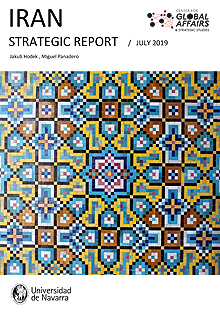 Report [pdf. 15,5MB] [pdf. 15,5MB
Report [pdf. 15,5MB] [pdf. 15,5MB
INTRODUCTION: IRAN IN THE MIDDLE EAST
This report will examine Iran's geopolitical presence and interests in the region, economic vulnerability and energy security, social and demographic aspects and internal political dynamics. These directly or indirectly affect the evolution of various international strategic issues such as the future of Iran's Nuclear Deal, United States' relations with Iran and its role in Middle East going forward. Possible power equilibrium shifts, which due to the economic and strategic importance of this particular region, possess high relevance and significant degree of impact even outside the Iranian territory with potential alteration of the regional and international order.
With the aim of presenting a more long-lasting report, several analytical techniques will be used (mainly SWOT analysis and elaboration of simple scenarios), in order to design a strategic analysis of Iran in respect to the regional power balance and the developments of the before mentioned international strategic issues. Key geopolitical data will be collected as of the announcement of the U.S. Secretary of State Michael R. Pompeo on the re-imposition of U.S. sanctions on the Islamic Republic of Iran on November 2, 2018 with a projection for the upcoming years, thus avoiding a simple narration of facts, which transpired so far.
First part of this report will be dedicated to a more general analysis of the geopolitical situation in the Middle East, with a closer attention to Iran's interests and influence. Then, after a closer look on the internal dynamics within Iran, several scenarios will be offered out of which some will be categorized and selected as the most probable according to the authors of this report.
Showing the range 1 - 10 of 13 results.

 [
[